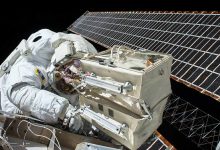Australian researchers have contributed to yet another world record for solar conversion efficiency, with researchers from the University of New South Wales involved in the production of new ultra-high efficiency gallium arsenide solar cells.
In a research paper published in the journal Advanced Energy Materials, the team of researchers from the University of New South Wales and the US-based National Renewable Energy Laboratory detailed how using gallium arsenide based semiconductors, solar energy conversion efficiencies of 32.9 per cent were achieved.
In fact, the UNSW-NREL team successfully achieved two new world records for solar efficiency, having produced two configurations of gallium arsenide solar cells that achieved new conversion efficiency records, including a single-junction solar cell with a 27.2 per cent efficiency, and a ‘tandem’ solar cell design that sandwiches together too different configurations, with an efficiency of 32.9 per cent.
Gallium arsenide solar cells work on on the same fundamental basis as conventional silicon-based solar cells, but the use of the different materials allows for much higher conversion efficiencies to be achieved, as they are able to utilise more of the solar spectrum to produce electricity.
However, solar cells produced using gallium arsenide are considerably more expensive than the silicon-based alternatives, as the materials are significantly less abundant than silicon.
This means that despite the higher efficiencies, gallium arsenide solar cells have generally been restricted to high-performance applications, where space and weight are at a premium. This has seen gallium arsenide solar cells used in the space industry, powering satellites, rovers and space stations, and many models of solar cars.
“High-efficiency solar cells are essential for high-density terrestrial applications, as well as space and potentially vehicle applications,” the research paper says.”
“In combination, these improvements lead to 27.2% efficiency in the single junction device and a 32.9% efficiency in the tandem device, both at one-sun global conditions.”
The researchers said they had incorporated layers of ‘quantum wells’ to improve the conversion efficiency of the solar cells by allowing the cells to trap and convert a larger portion the energy contained in sunlight into useful electricity.
The “quantum wells” were created by sandwiching together more than 150 ultra-thin layers of semiconductor materials, that are tuned to facilitate the absorption of solar energy at different wavelengths. In producing the record setting solar cells, the researchers alternated layers of gallium indium arsenide and gallium arsenide phosphide.
By allowing the solar cell to absorb light from a wider range of the solar spectrum, the solar cell is able to produce more electricity from available sunlight, increasing the cell’s efficiency of converting sunlight into useful electricity.
“This work leads to higher efficiency solar cells for one-sun applications, which is a significant driver of the potential for widespread adoption of these cells,” Myles Steiner, a senior scientist on the NREL team said. “Now, a key challenge ahead is to learn how to manufacture these cells in a cost-competitive manner.”
The research is the result of a collaboration between two of the world’s leading solar energy research institutions, based in Australia and the United States, and saw researcher Myles Steiner from NREL travel to the University of New South Wales to progress the research with the help of a three month grant from the Fulbright Scholars Program.
“Our partnership brought together NREL’s long standing expertise in epitaxial growth and UNSW’s work in solar cell modelling, which helped us to collaborate effectively at a distance,” Nicholas Ekins-Daukes, who led the UNSW team, said. “I was impressed with how quickly we were able to develop the first composite, strain-balanced semiconductor material to outperform a conventional solar cell.”










